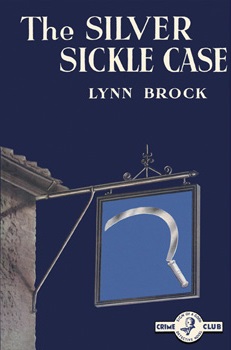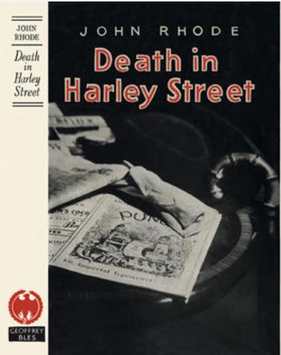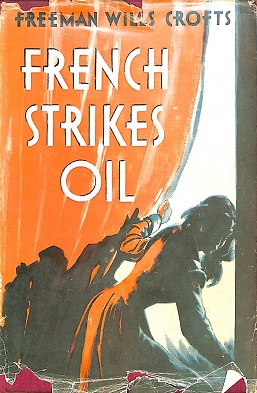
The "locked-room" or "impossible crime" mystery is a type of crime seen in crime and detective fiction. The crime in question, typically murder, is committed in circumstances under which it appeared impossible for the perpetrator to enter the crime scene, commit the crime, and leave undetected. The crime in question typically involves a situation whereby an intruder could not have left; for example the original literal "locked room": a murder victim found in a windowless room locked from the inside at the time of discovery. Following other conventions of classic detective fiction, the reader is normally presented with the puzzle and all of the clues, and is encouraged to solve the mystery before the solution is revealed in a dramatic climax.

The Verdict of You All is a 1926 mystery detective novel by the British writer Henry Wade, his debut novel. Both this and his following novel The Missing Partners revolve around potential miscarriages of justice. It was published in the United States by Payson and Clarke in 1927. A success it launched his career as one of the prominent writers during the Golden Age of Detective Fiction. The title refers to the traditional question asked in court by a judge of the jury to establish whether they have reached a unanimous verdict.

Treason in My Breast is a 1938 mystery detective novel by Anthony Gilbert, the pen name of British writer Lucy Beatrice Malleson. It is the fourth in her long-running series featuring the unscrupulous London solicitor and detective Arthur Crook. Crook became one of the established characters of the Golden Age of Detective Fiction, although in this case the novel was more similar to a Victorian melodrama than a conventional whodunnit.
Irish writer Alister McAllister [1877-1943] wrote several plays under the pseudonym Anthony Wharton and later, after moving to England, wrote a series of mystery novels using the pseudonym Lynn Brock.

The Slip-Carriage Mystery is a 1928 mystery detective novel by the Irish-born writer Lynn Brock. It was the fourth novel in his series featuring the character of Colonel Wyckham Gore. The previous novels in the series established Gore a popular character during the early stages of the Golden Age of Detective Fiction. A review in the Times Literary Supplement observed "The multiplication of false leads at the beginning is carried a little too far, and the story is at its best when the movement is greatest as it approaches and reaches its end".

The Mendip Mystery is a 1929 mystery detective novel by the Irish-born writer Lynn Brock. It was the fifth of seven novels in his series featuring the character of Colonel Wyckham Gore, one of the most prominent investigators during the early stages of the Golden Age of Detective Fiction. It was published in America with the alternative title of Murder at the Inn.

The Deductions of Colonel Gore is a 1924 detective novel by the Irish-born writer Lynn Brock. It was the first in his series of seven novels featuring the character of Colonel Wyckham Gore. Gore enjoyed popularity during the early stages of the Golden Age of Detective Fiction. It was also published under the alternative title The Barrington Mystery.

Colonel Gore’s Second Case is a 1925 detective novel by the Irish writer Lynn Brock. It was the second in his series of seven novels featuring the character of Colonel Wyckham Gore. Gore enjoyed popularity during the early stages of the Golden Age of Detective Fiction. After solving his first case Gore now establishes his own detective agency.

The Kink is a 1927 mystery detective novel by the Irish-born writer Lynn Brock. It was the third novel in his series featuring the character of Colonel Wyckham Gore, one of many investigators active during the Golden Age of Detective Fiction. It is sometimes referred to as Colonel Gore’s Third Case. The novel is noted for being comparatively sexually explicit for the era. Dashiell Hammett wrote a contemporary negative review of the book in The Saturday Review.

The Stoat is a 1940 mystery detective novel by the Irish-born writer Lynn Brock. It was the seventh and last novel in his series featuring the character of the Golden Age detective Colonel Wyckham Gore. It was also his last published work before his death three years later. It marked a return for Gore, who hadn't appeared in a novel since 1930.

The Dagwort Coombe Murder is a 1929 mystery detective novel by the Irish-born writer Lynn Brock. It was the first stand-alone novel by Brock following the success of his Golden age detective Colonel Gore. It was published in the United States with the alternative title The Stoke Silver Case.

The Silver Sickle Case is a 1938 detective novel by the Irish-born writer Lynn Brock. Best known for his Colonel Gore series of mysteries, the novel introduced an alternative detective character Sergeant Venn of Scotland Yard assisted by Detective Constable Kither. It was followed by two sequels.

The Riddle of the Roost is a 1939 mystery detective novel by the Irish-born writer Lynn Brock. It was the third and last in his trilogy featuring the characters of Scotland Yard detective Sergeant Venn and Constable Kither. It was Brock's penultimate novel, followed the next year by The Stoat a final entry into the series of his best-known character Colonel Gore.

Death on the Way is a 1932 detective novel by the Irish writer Freeman Wills Crofts. It is the ninth in his series of novels featuring Inspector French, a prominent figure of the Golden Age of Detective Fiction. It was published in the United States the same year by Harper under the alternative title Double Death.

Death in Harley Street is a 1946 detective novel by John Rhode, the pen name of the British writer Cecil Street. It is the forty third in his long-running series of novels featuring Lancelot Priestley, a Golden Age armchair detective. Several sources consider it to be the author's masterpiece.

Death Invades the Meeting is a 1944 detective novel by John Rhode, the pen name of the British writer Cecil Street. It is the thirty ninth in his long-running series of novels featuring Lancelot Priestley, a Golden Age armchair detective. Reviewing the novel for the Times Literary Supplement Maurice Willson Disher noted "His ingenuity is becoming as delicate to handle as high explosive. His stories may become so difficult to review without saying too much that his triumph will come when they cannot, for discretion’s sake, be reviewed at all."

The Fourth Bomb is a 1942 detective novel by John Rhode, the pen name of the British writer Cecil Street. It is the thirty sixth in his long-running series of novels featuring Lancelot Priestley, a Golden Age armchair detective. In The Observer Maurice Richardson wrote "Inspector Waghorn does the investigating, but the evidence is so contradictory and suspicion so widely distributed that the solution calls for Dr. Priestley, whom, you will be sorry to hear, I thought was looking alarmingly shaky. Sound recommendation, of course" while Isaac Anderson in the New York Times wrote "It is merely the familiar Dr. Priestley formula set against the background of wartime England."

French Strikes Oil is a 1951 detective novel by the Irish-born writer Freeman Wills Crofts. It is the twenty eighth and penultimate entry in his series of novels featuring Inspector French, a Scotland Yard detective of the Golden Age known for his methodical technique. It was published in the United States by Dodd Mead under the alternative title of Dark Journey.

Nightmare is a 1932 thriller novel by the Irish-born writer Lynn Brock. It is an inverted detective story, and a stand alone work for an author best known for his series featuring the Golden Age detective Colonel Gore.

The Case with Nine Solutions is a 1928 detective novel by the British writer Alfred Walter Stewart, published under his pseudonym J.J. Connington. It is the forth in his series of novels featuring the Golden Age Detective Chief Constable Sir Clinton Driffield. It was published in London by Gollancz and the following year in Boston by Little, Brown and Company.



















